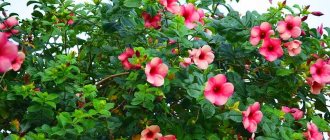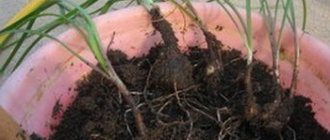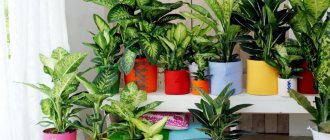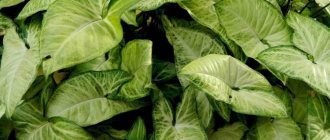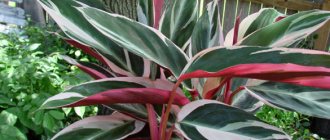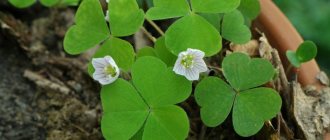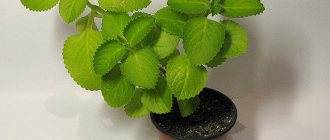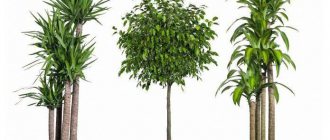Alocasia Red Secret
A variety of copper alocasia, Alocasia cuprea Red Secret, grown as a houseplant, appeared in the collections of gardeners not long ago, but thanks to its unusual appearance and texture of oval leaves, it has become one of the most popular varieties.
The size of adult specimens, not exceeding 50 cm, makes it easy to keep the flower in any apartment, and the quilted, violet-silver foliage, as if stamped on a sheet of copper, is sure to attract attention and decorate the interior.
The leaf blades are dense and leathery. The lower part has a brighter purple hue than the upper. The cuttings are erect, but as the leaves grow they bend into the ground. The leaves of Alocasia Red Secret reach 30 cm in length, and even upon closer examination it is difficult to believe that the plant is alive and not skillfully made from a sheet of copper.
Pests and diseases
If all conditions are created for the plant, then its immunity is quite high, and pests and diseases do not threaten it, which means it will not have to be treated. The most common parasitic insects:
- aphid;
- scale insect;
- spider mite;
- mealybug.
Signs that your home alocasia plant needs treatment are:
- the appearance of spots on the leaves (yellow, brown, bicolor). Spots are an indicator that the plant is not feeling well;
- yellowing, falling, wilting, shredding of leaves;
- complete loss of leaves;
- rot on any part of the flower.
Insecticides will help against insects, and fungicides will help against diseases.
All these are signs of various diseases caused by improper care. To avoid this, you need to follow all the rules, then you won’t have to treat the flower. Well-groomed alocasia is not susceptible to disease.
Alocasia is a very beautiful, original, exotic plant that loves space and proper care. If you provide her with everything the plant needs, she will give the owner a beautiful appearance and will delight with large, bright, wide leaves. Caring for her is not always easy, but the results are worth it.
Alocasia Bambino
Alocasia Bambino is a miniature and very original plant that behaves perfectly on window sills and flower racks in apartments. The height of the bush reaches 40 cm, which makes the variety of alocasia shown in the photo an ideal crop for limited space. Despite its miniature size, the plant is sure to attract attention thanks to its arrow-shaped dark green foliage with a purple tint. The back side of the leaf blades is deep purple, the veins are bright, white or yellowish-green.
“ Alocasia Cucul Bambino ” on a flower pot, the gardener should not think that he is seeing a new variety. In this way, some nurseries designate ordinary plants of the Bambino variety, along with it they grow creeping plants of a similar species.
How often does alocasia bloom?
To see alocasia bloom, you need to create special conditions for it with high tropical humidity. In modern apartments this is not an easy task. Some plants of this species are occasionally capable of throwing out the inflorescence, while others will never bloom.
In general, alocasia that has reached the age of 7 years is capable of blooming. Most often, inflorescences appear in pairs with a new leaf, replacing the old one that falls off. The flower is covered with a kind of blanket that wraps it in a cocoon; after the seeds ripen, it gradually disappears.
The weatherflower flower has a rather strong aroma. Its flowering period falls in the summer, when the plant receives sufficient light and moisture. Moreover, it is not constant watering, but a slight drought that can stimulate alocasia to bloom.
Interesting fact: the plant is not able to nourish both foliage and flower at the same time. Therefore, the owner must choose what he likes to admire more: the blooming crown or lush foliage. It is worth noting that after the end of the flowering period, alocasia rests for 3 months.
Alocasia flowering
Alocasia Bambino Arrow
Like the Bambino variety, its sister, Alocasia Bambino Arrow is a plant mini-form of Alocasia Amazonica. The varieties have a lot in common. The special charm of this variety of alocasia, shown in the photo, is given by the silvery sheen on the glossy dense leaves, which bear a complete resemblance to an ancient arrowhead.
The back of the leaves is purple, with white or silver veining marks. Alocasia Bambino Arrow feels best in partial shade, despite its apparent resistance to dryness; plants, like all other representatives of the species, are very demanding on the amount of moisture received and atmospheric humidity.
About the plant
Alocasia is a large, evergreen, herbaceous plant. As a rule, it has a developed aboveground stem, covered with scars - leaf traces of dead leaves. Young plants have a shortened stem. At the top of the stem there are several very large oval-arrow-shaped leaves.
Its leaves are thick, dense and almost leathery. Leaf blade with thick veins protruding on both sides; leaf petioles are long, succulent, with a long sheath. With good care, the plant develops 6-7 leaves, and the size of the leaf blades can reach 50-80 cm in length.
On a note !!!
The leaves have aqueous stomata-hydathodes, through which droplets of water are released in wet weather or when overwatered.
Sometimes it blooms in summer. The flowers are very small, collected in a spadix, equipped with a large light cover.
Alocasia flower
Alocasia is a fairly unpretentious plant that requires regular but simple care. It grows well in warm and humid microclimates. If you provide your tropical beauty with conditions close to natural, then she will delight you with her exotic beauty.
On a note !!!
If the leaves on an alocasia periodically turn yellow and disappear (one at a time, and not all at once), this is a normal process - a new one is already growing in place of the missing one.
Alocasia Purple Sword
Alocasia lauterbachiana Purple Sword really resembles a bunch of bladed weapons waiting to be used in combat. The leaves are shaped like jagged oriental swords and gave the indoor alocasia pictured in the photo such an unusual name.
The graceful, elongated leaves are dark green in color and are held on the stem by purple or violet cuttings, sometimes with a fancy variegated pattern. The resemblance to swords is given to the plant by the vertical position of the foliage, which does not sink to the ground even when the above-ground part has grown. This variety of alocasia, according to the description and photo, is best kept separately from others. In this case, the plant looks most advantageous. The maximum height of the bush reaches 120 cm.
Transplantation and propagation of alocasia
It is advisable to replant alocasia 1–2 times a year. As a rule, a young plant can grow out of its pot in just 4 months, so it will have to be replanted twice a year. But a mature alocasia can be replanted after a year in order to give it more nutrients with new soil.
Breeding alocasia goes like this:
- You need to shake off the soil from the roots;
- tubers found among the roots can be planted separately;
- to obtain adventitious shoots, you can slightly deepen the roots of the plant;
- you need to replant the flower in a pot that is wider than the original one, and be sure to put expanded clay drainage on the bottom.
Rhizome division
Alocasia can be propagated by dividing its rhizomes. It is important to remember that this method must be combined with the annual replacement of the plant’s soil (from late March to early May).
Reproduction by dividing the rhizome is done as follows:
- first you need to carefully remove the soil without damaging the rhizomes;
- if the soil is compacted, you can moisten it a little under running water;
- Now you need to divide the rhizomes with a knife, be sure to leave a growth bud or rosette with foliage on each part;
- now the place where the rhizome was cut needs to be sprinkled with charcoal dust and left for 1 hour to dry completely;
- when the cut dries, it is transplanted into prepared soil and watered abundantly;
- now it is enough to maintain the air temperature at 24 degrees and regularly spray the plant; during this period you need to keep alocasia away from sunlight.
Tuber planting
In the spring, when tubers appear on the surface of the soil, they can be transplanted. It is not uncommon for tubers to begin to grow directly in the pot with the flower from which they came. In this case, careful separation of the tuber from the mature plant is required.
After this, the tubers need to be germinated; sphagnum moss will help for this purpose; it should be regularly moistened, preventing changes in the ambient temperature and maintaining it within 22–24 degrees. You can put a plastic bag over the pot with the germinating tubers to create the maximum level of humidity.
After the tuber germinates and the leaf peeking out from it unfolds, the young plant can be transplanted into the soil. You can start feeding this plant with fertilizers and minerals immediately after at least three leaves appear.
Using cuttings
Those varieties of alocasia that are decorated with emerald foliage can easily be propagated by cuttings. To do this, the following manipulations are carried out:
- The top of the shoot is cut with a knife at an angle of 45 degrees.
- Before planting the cutting, you need to treat it with a special product to stimulate growth (for example, “Novinka”).
- Now the cuttings can be planted in the soil prepared in a pot and watered generously with warm water.
- For better growth of alocasia, you need to create the most comfortable conditions for it:
- air temperature at 23 degrees;
- regular watering and spraying;
- no drafts.
It is important to remember that all work with alocasia should be carried out wearing protective gloves. At the same time, avoid allowing the plant juice to come into contact with the skin of the hands, face or mucous membranes.
Alocasia Elaine
In apartment conditions, Alocasia wentii Aline does well at temperatures of 18–22 °C. This rather large plant attracts attention with its size and stunning variegated leaves. According to the description and photo, alocasia of this species can grow up to one and a half meters in height, which at home requires the allocation of a fairly large area.
In order for Alocasia Elaine to look most advantageous and be as decorative as possible, the plant is placed in a bright place, still protected from direct sunlight. Like other varieties of alocasia, this variety needs sufficient watering. The plant will remove excess moisture through special stomata on the leaf blades, which is very reminiscent of the “crying” of an indoor crop.
Common varieties: description and photo
There are more than 50 cultural varieties . All of them are different from each other in height, variety of leaf shapes and their colors. When grown at home, alocasia rarely blooms. Most often you can find several of the most famous varieties and their indoor hybrids. The following is a brief description and photo of the most common plant species.
Klobuchkovaya
Alocasia cucullata – does not grow higher than 1 m. It has dense, shiny, bright green leaves with dark green veins, up to 1 m long and up to 80 cm wide. There is a noticeable swelling on the front side of the leaves opposite the place where the petiole is attached.
In adult plants, daughter tubers are formed close to the mother tuber. This species does not bloom when grown at home.
Large-rooted (Arma)
Alocasia macrorrhizos - it is also called large rhizomatous, Indian, mountain, medicinal or arma . It grows 2 m in height, and thick succulent petioles grow more than 1 m. The ovoid leaves are dense, smooth, evenly green, up to 80 cm wide and up to 90 cm long. Pleases with light cream inflorescences, and after flowering large scarlet berries appear . Her indoor hybrids are very beautiful and grow up to 40 cm:
Alocasia macrorrhizos Variegata
Its leaves are smaller and variegated with large white spots.
Black stem
It has dark purple or brown stems and petioles.
Plumbea or metallica
It is famous for its pronounced metallic tint on both sides of the leaves and brown or purple petioles.
Alocasia macrorrhizos Stingrey
Its leaves are glossy, rich green, rounded and heart-shaped.
Copper red
Alocasia cuprea is a small and very beautiful species. The heart-shaped oval leaves are directed upward and reach a length of 25-35 cm, a width of up to 20 cm. The front side of the leaves is copper-green with a metallic sheen, and the back side is purple. The most beautiful hybrid is red secret .
Red secret
Cuprea 'red secret' is known for its color - the front side of the leaves of a young flower is red, while that of an adult is silver-green with reddish highlights. The reverse side is purple. The large fleshy leaves of this variety have a corrugated surface.
Amazonian
Alocasia amazonica - its stem and petioles are painted with dark stripes on a pinkish-green background. The dark green leaves are elongated, with clearly defined lobes and with white stripes along the lateral veins. The leaves grow up to 20 cm wide and up to 50 cm long. It blooms in white and pink clusters, but the berries do not ripen at home. The most famous hybrid is Polly.
Polly
Alocasia amazonica 'polly' does not grow higher than 65 cm . The intricately serrated leaves are succulent dark green with a metallic sheen and large white vein patterns, the edges and tip are intricately serrated. Polly blooms less often than other varieties.
Sandera
Alocasia sanderiana - is distinguished by short tuberous roots, as well as the largest leaves among indoor varieties - 15 cm wide and up to 40 cm long. Arrow-shaped, elongated, with intricately jagged edges, they are green with a dark metallic tint and light-colored edges and lateral veins. The most famous hybrids are bambino and silver bambino.
Bambino (Bambino)
It does not grow higher than 30 cm. The leaves are narrower than those of sandera, and the veins are greenish-white. Blooms with white and purple inflorescences.
Silver bambino
It grows up to 35 cm. Its matte silvery leaves with light painted veins are dark red on the back side.
The Dragon
Alocasia Dragon - its amazing leaves are like dragon wings - heart-shaped, with a solid edge and clear dark green veins; when the viewing angle changes, they change color from light green to dark green, which creates the illusion of volume.
Very popular among alocasia lovers are its hybrids, silver dragon and dragon scales.
Silver dragon
It is very similar to alocasia dragon, but has a special silvery tint.
Dragon scale
Dragon skin, dragon scales - up to 30 cm high. Oval matte leaves up to 20 cm wide are painted gray-green and painted with dark green patterns. They really resemble dragon scales and still have the same optical three-dimensional effect.
Reginula
Alocasia reginula - it has glossy leaves with a sharp tip, rich dark green color. Her amazingly beautiful hybrid “Black Velvet” is better known .
Black velvet
The velvety leaves are heart-shaped and painted with a pattern of veins on a black and burgundy background on the front side and green on the back. This flower regularly pleases lovers with pink inflorescences with a white and pink cover.
Venti
Alocasia wentii – grows up to 1.2 m. Large silver-green, heart-shaped leaves, purple on the reverse side, are very beautiful.
Lindena
Alocasia lindeni - this species is less common, but gardeners consider it one of the most beautiful. It has gray rough petioles and green dense leaves with whitish patterns.
Smelly
Alocasia odora is the most famous variety. It is also called fragrant alocasia or night lily . It reaches a height of 2.5 m. It has fleshy and wide, up to 80 cm, oval leathery leaves with a wavy edge. Blooms in light pink or yellowish-cream clusters.
Gives off a very pleasant specific smell. Famous for its medicinal properties and well known in traditional oriental medicine.
Zebrin and Calidor hybrids are also very famous for their wonderful scent and fancy colors.
Zebrina (Zebrina)
It is unique for its variegated coloring - long, up to 40 cm, arrow-shaped leaves are painted with fancy dark green patterns of veins on a light green or olive background. This variety even has variegated petioles. Zebrina is less fragrant, but retains its unique aroma.
Calidora
Reaches 2.2 m in height. The pointed leaves are rounded along the upper edge, thick and long up to 1 m. It also emits a magical smell.
Lowe
Alocasia Lowii – grows up to 1 m in height. This species grows on a short trunk with long, arrow-shaped leaves that are green with white veins and purplish-violet on the back.
Alocasia macrorrhiza New Guinea Gold
Alocasia large-rooted, Indian or macrorrhiza in nature can reach three meters in height. And although the New Guinea Gold variety is somewhat more compact and does not exceed 1.8 meters in height, the plant enjoys increased attention from both botanists and flower growers.
The fact is that the variety of alocasia shown in the photo was found in Papua New Guinea and still poses a mystery to the scientific world. Scientists cannot explain why and how golden spots appear and disappear on the leaves of the plant. Peltish coloring is present on the stems, veins and petioles of Alocasia of this rare variety. But even with large green leaves, Indian alocasia, as in the photo, is always attractive and will become a bright decoration of any spacious room.
Possible difficulties
When growing alocasia, you should pay attention to the following difficulties that gardeners usually encounter when growing this plant:
- Alocasia has stopped growing. This situation arises for two reasons: either the plant needs replanting or is experiencing a deficiency of minerals. The solution here is very simple; the flower needs to be transplanted into a larger pot or, if the container is normal for the plant, fed.
Alocasia diseases - Alocasia leaves wither. This problem occurs when the soil is excessively waterlogged. It can also occur when the earthen lump is very dry. In this case, it is enough to adjust the watering. If, even after normal watering, the leaves continue to wither, it means that the soil in the pot is too dense. In this case, you should change the soil to a looser and more breathable one.
- Alocasia leaves have turned pale or changed color. This situation occurs with aging and dying leaves. In place of the old fallen leaves, after a certain period of time, new leaves grow. The drawing on the sheet may fade due to lack of light.
- The tips of the leaves dry out and turn black. The reason is lack of watering, low light, low air humidity.
- Dark spots have appeared on the leaves of Alocasia. There may be several reasons: drafts, hypothermia, too dry or vice versa, damp soil, overdose of fertilizers. Dark spots sometimes appear due to mechanical damage, waterlogging of the soil and excessive application of nitrogen fertilizers. This situation often leads to the occurrence of fungal and bacterial rot. In this case, the rotten place is treated with fungicides or the plant is transplanted into new soil.
- Rotting of the rhizome. This problem occurs when the room temperature is low, there are drafts, and the plant is flooded so that the soil does not have time to dry.
Alocasia odora Variegata
Even more rare is Alocasia odora Variegata, one of the largest Alocasia grown at home. And this variety also stands out for its variegated decorative foliage in the shape of a huge elephant’s ear.
Interestingly, white or light green areas on leaf blades can look like a scattering of small streaks or create large discolored spots. The length of an adult leaf of the alocasia variety shown in the photo is about 60 cm, the height of an adult plant can reach 2 meters.
Tricks for caring for Alocasia
The crowning achievement of a gardener's efforts to care for houseplants is their flowering. Therefore, achieving flowering even for ornamental plants with large leaves is always a task for the master. On numerous gardening forums there is a lot of advice and happy owners show photos of alocasia flowers. There are also those who show the consequences of receiving seeds from their pets.
The main stimulus for flowering is considered to be two mutually exclusive aspects. It is necessary to create the necessary microclimate, humidity and nutrition regime, on the one hand. On the other hand, dry out an adult plant for a short time before the onset of spring. Such a trick for caring for alocasia will shake it up and force it to consider procreation with seeds, since the roots have become uncomfortable in this place. And then the bud of a flower will begin. Further good care will not stop the development of the cob.
Alocasia zebrina reticulata
The photo of Alocasia zebrina perfectly conveys all the unusualness of this plant. Thin dark green stains, reminiscent of a pattern on marble or on the skin of an African animal, are clearly visible on the light background color of the leaf plates. The shape of the leaves covered with a thin waxy coating is conical, similar to the outline of a spear or arrow tip. The leaf cuttings are also variegated, thin, and erect. Decorative leaves grow up to a meter in length. According to the description and photo of alocasia, the plant sometimes reaches 180 cm in height.
Soil selection, feeding and fertilizing alocasia
The ideal composition for growing alocasia will be one of the following:
- special soil with the inclusion of disintegrants (charcoal, sand or perlite);
- mixture for coniferous soil and birch coal;
- the presence of sphagnum and moss in the soil for alocasia is important;
- a good composition includes: garden soil, peat, orchid mixture, perlite and sphagnum, which is finely chopped;
- the plant behaves well in soil with the following composition: pine soil, high peat, sphagnum;
- a mixture of peat and soil from a greenhouse.
Most species of this plant love slightly acidic soil, and copper-red alocasia only accepts a substrate containing dolomite flour or lime. In addition, it is important to organize drainage at the bottom of the pot; its thickness should not be less than 2 cm.
Principles of fertilizing alocasia:
- In the summer, fertilizers are applied once every two weeks, and it is better to dilute the dose so as not to overload the plant with excess salt content.
- In winter, fertilizing is carried out once a month.
- Alocasia tolerates Agricola and Belvito fertilizers well.
- Fertilizing with bird droppings, which is diluted with water in a ratio of 1 to 30 and left for 5 days, helps the growth of the flower well.
- You can also use surface fertilizers for foliage. They should be less concentrated to prevent burning of the leaf plates.
There is also an opinion that there is no need to fertilize and feed alocasia. It is enough to replant it in fresh soil once a year.
Alocasia Hilo Beauty
The variegated leaves of this stunning Alocasia Hilo Beauty make the plant stand out even among the taller species. The shape of the foliage of this variety of alocasia, as in the photo, most closely resembles a heart. But the value of the plant is not only in the size and shape of the leaves, but also in their color. Each green is generously decorated with light yellow-green spots of irregular shape. Looking at this creation of nature, one may recall military camouflage or the coloring of frogs. The edges of the leaf blades are wavy, the cuttings are erect and strong.
The indoor alocasia shown in the photo can bloom even in an apartment, but the inflorescence is inconspicuous and almost invisible compared to the foliage. To maintain a decorative appearance, it is better to grow Alocasia Hilo Beauty in a partially lit place, where the plant will not suffer from sunburn, but will not remain in complete shade, where the foliage will gradually become almost green.
History of origin
It is believed that the birthplace of copper-red alocasia is the island of Kalimantan (Borneo). It is located in a place where three seas meet, it is always hot and it rains often. The island is covered with rocks and tropical forests.
It is difficult to create tropical island conditions in an apartment, but you can get closer to them by providing the plant with regular watering, spraying and sufficient humidity in the room.
The soil on the island is rich in limestone, so indoor alocasia, like its distant island relatives, does not like acidic soil .
Why problems arise and how to solve them
Mistakes in caring for alocasia most likely will not kill it, but will negatively affect its decorative properties.
Table: alocasia has dropped its leaves, is stained, turns yellow or dries out - we eliminate typical care mistakes
| Problem | Probable Cause |
| The flower stops growing | The plant lacks nitrogen. Water the alocasia with a solution of urea or ammonium sulfate (1 g/l). |
| Leaves lose their tone, droop, wither |
|
| Leaves lighten and lose color |
|
| The tips of the leaves turn brown and dry out | The flower feels a lack of moisture. You don't water it enough or the air in the room is too dry. |
| Dark spots on the leaves |
|
| Alocasia is losing its leaves |
|
| The bases of the petioles turn black | Excessive watering combined with low temperatures led to root rot or fungal disease. The flower needs appropriate treatment. |
The toxicity of alocasia repels many pests. But there are also those who are not stopped by this. However, plants that are weakened by improper care most often get sick.
Table: how to recognize diseases and pests and deal with them
| Problem | Symptoms | What to do |
| Spider mite |
|
|
| Aphid | Clusters of insects are visible to the naked eye |
|
| Shchitovka | Convex dull brown growths and sticky coating on leaves |
|
| Mealybug | At the point where the leaf petiole attaches to the stem, lumps appear that resemble dirty cotton wool. |
|
| Black rot | The bases of the petioles and stems turn black, the leaves fall off, the roots rot | A badly damaged plant cannot be saved. It is thrown away, and the pot and tray are disinfected in boiling water.
|
Photo gallery: diseases and pests of alocasia
There are no effective ways to treat black rot; you can only try to save the plant by performing a “surgical operation”
Flowers infected with mealybug stop growing
Scale insects have strong shells, so not all insecticides are suitable for combating them.
To prevent the appearance of aphids, preventive measures are sufficient
Spider mites can completely entangle a plant with whitish threads.
Watering
During the period of active growth, the compost should always be moist. It should be moist, not dry or wet. Does not like dry roots, but too much water will cause root rot. How to water a flower to avoid excess or lack of moisture?
Unlike regular watering of houseplants, we have found that the best way is to water lightly and often. Use cool rainwater if possible, but it is not necessary.
Video: alocasia in a flower shop
Many gardeners who like alocasia are simply afraid to plant an exotic flower, fearing the difficulties associated with creating suitable conditions and care. However, the plant is not at all capricious if you initially provide it with a suitable place without bright light, high humidity and a “breathing” container with good drainage. And the variety of existing varieties will allow you to create a whole collection if you wish.
- Author: Yulia Golova
27 years old, higher legal education, broad outlook and interest in a variety of topics. Rate this article:
- 5
- 4
- 3
- 2
- 1
(1 vote, average: 4 out of 5)
Share with your friends!
